December 31, 2003 — 2003 marked the 45th anniversary of NASA and the 100th centennial of the Wright Brothers first flight. It was 35 years since the first crewed mission orbited the Moon (Apollo 8) and 45 years since the United States launched its first satellite (Explorer 1).
Yet it was current space events, rather than the passing of anniversaries, that drew the most reflection on space history in 2003. If the top space headlines had a common theme, it was a connection to the successes and failures of the past four decades of space flight.
To illustrate the role space history had in shaping space exploration in 2003, what follows are the top five events, as voted by collectSPACE readers.
#1 Hail Columbia
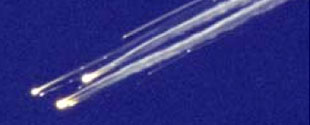
"Their dedication and devotion to the exploration of space was an inspiration to each of us..."
These words could have been spoken of the fallen crew of Columbia, who were tragically lost February 1st, only minutes from completing a 16-day research mission.
In fact, they were the words of the ill-fated mission's commander Rick Husband, speaking from space of the Apollo 1 and STS-51L crews on the anniversaries of their loss. "They made the ultimate sacrifice, giving their lives and service to their country and for all mankind," radioed Husband from Columbia four days before similar tributes would be made for him and his crew.
Parallels would be drawn between the three tragedies, and in particular the two shuttle accidents. Their proximity on the calendar may have begun the comparisons, but it was the findings of the STS-107 investigation board that raised serious questions about what lessons were really learned from 17 years earlier.
#2 Godspeed, Yang Liwei
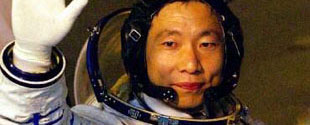
If February 2003 felt like January 1986, than October harked back to April and May 1961.
After 40 years, a nation other than Russia and the U.S. was ready to launch its own astronaut. The space race long over, speculation rose with each unmanned test whether a new challenge would emerge from China. With statements circulating about moon missions and space stations, not to mention concerns over the communist nation's military plans, it appeared a new power in space was beginning to stretch its muscle.
But first things first: on October 14, Lt. Col. Yang Liwei boarded Shenzhou 5 for a 14-orbit spaceflight. China had its first 'taikonaut', who was quickly hailed as a hero and was celebrated with parades reminiscent of those staged for Yuri Gagarin and Alan Shepard.
#3 Parting with Past Probes
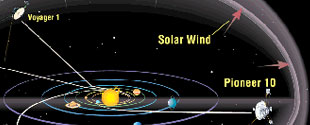
Speaking of races, Voyager 1 was once again confirmed as the farthest man-made spacecraft as the former title holder, Pioneer 10 ceased responding, its power source depleted. At a distance equivalent to 90 times that from the Earth to the Sun, Voyager 1 entered a region of space unlike anything we have ever encountered as it continued towards the edge of our solar system.
In the 1970s, Pioneer and Voyager delivered us our first close-up views of Jupiter but it was another probe to bid farewell in 2003 that unveiled the Jovian system. After 14 years exploring the asteroid belt, Jupiter and its moons, Galileo collided with the gas giant to avoid contaminating potential life on the ice moon Europa.
The legacy of these three robotic spacecraft may be the drive that ultimately sends humans further into the solar system, faster than what was previously possible. JIMO (Jupiter Icy Moons Orbiter) took shape this year after its reactor-driven propulsion drive was first proposed in 2002.
#4 The Return of Apollo?
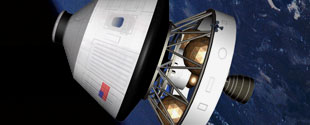
With the Space Shuttle fleet ground for much of the year, new urgency was placed on insuring access to the Space Station. Though the initial concepts for a new crew return or transfer vehicle took the shape of mini-shuttles, they quickly gave way to designs closer to the command and service modules of Apollo.
The crew return vehicle evolved into the Orbital Space Plane, though despite its name, the leading candidates at the end of the year still retained their capsule designs.
The approach was bolstered when it was rumored late in 2003 that the President might use his appearance at the site of the Wright Brothers' first flight to announce a return to the Moon, this time to stay. Though the Administration denied any such decisions or pending speeches, they did confirm that a new space policy was under consideration.
#5 Access to Archives
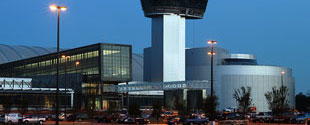
When NASA first began looking at a return to capsules, the agency considered using existing Apollo hardware in museums and storage. The idea of raiding the archives was rejected, but it that did not stop Apollo artifacts from leaving collections.
Three national air and space museums reported this year missing hundreds of items from their archives, the result of curators and conservators stealing. Coupled with the trial of four students found guilty of lifting (literally) a 600 pound safe filled with Apollo recovered moon rocks from NASA Johnson Space Center and the return of an acrylic encased lunar sample to Honduras after it was stolen, the nation's archives began increasing the barriers between public and their artifacts.
Bucking the trend, the Smithsonian opened the doors to the Steven F. Udvar-Hazy Center, 'storage on display' for the always popular National Air and Space Museum.
Was 2003 history relived or anew? Share your year-end reviews the events this list included and those ommitted.
